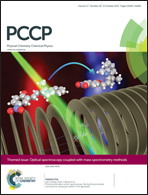H–Si bonding-induced unusual electronic properties of silicene: a method to identify hydrogen concentration
Abstract
Hydrogenated silicenes possess peculiar properties owing to the strong H–Si bonds, as revealed by an investigation using first principles calculations. Various charge distributions, bond lengths, energy bands, and densities of states strongly depend on different hydrogen configurations and concentrations. The competition between strong H–Si bonds and weak sp3 hybridization dominate the electronic properties. Chair configurations belong to semiconductors, while the top configurations show a nearly dispersionless energy band at the Fermi level. Both the systems display H-related partially flat bands at middle energy and the recovery of low-lying π bands during the reduction of concentration. Their densities of states exhibit prominent peaks at middle energy, and the top systems have a delta-funtion-like peak at E = 0. The intensity of these peaks is gradually weakened as the concentration decreases, providing an effective method to identify the H-concentration in scanning tunneling spectroscopy experiments.


 Please wait while we load your content...
Please wait while we load your content...